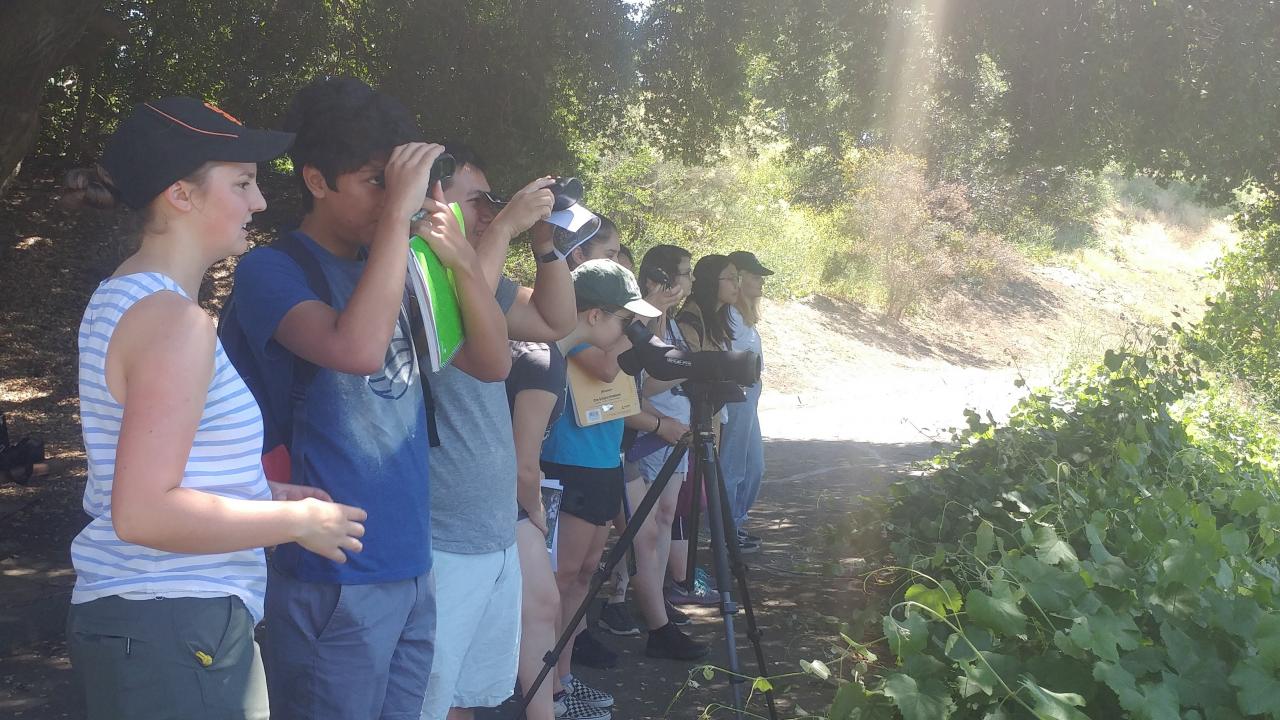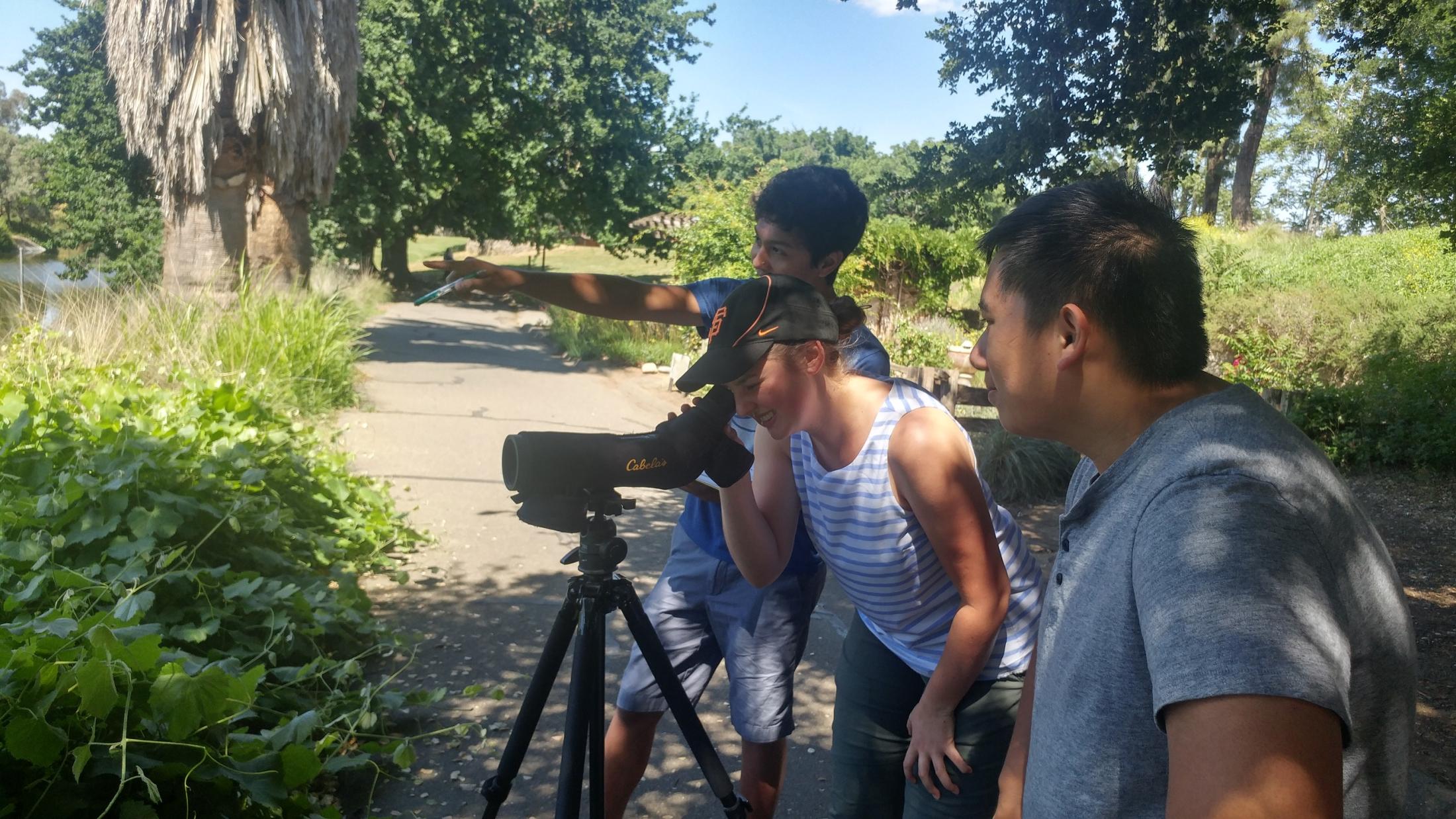
A Day in Class: Wild Davis Course Gets First-Year Students Outside
If you look at the valley oak trees in UC Davis Arboretum’s California Foothill Collection, you might notice something odd. Growths on the trees’ branches. At a glance, it’s easy to mistake these growths, colloquially referred to as “oak apples,” for fruits, but they’re actually the result of wasps laying eggs on the valley oak’s leaves and twigs. The oak apples act as incubators for wasp larvae.
On a sunny spring afternoon, students in the First-Year Seminar class “Wild Davis” ambled through the arboretum’s oak grove, inspecting the trees and their growths. Around them, oak apples blanketed the ground, their ashen brown color blending with the fallen leaves. As bicyclists and pedestrians passed by on the neighboring path, the students logged ecological interactions. Were any leaves curling from moth damage? What about the presence of spiders or aphids?
Quick Summary
- UC Davis First-Year Seminars provide new students with opportunities to engage in intellectual exchange, critical thinking and the UCD community
- The Wild Davis course aims to connect students with the plants and animals that call UCD home
- Students in the course have explored the Arboretum, oberserved turtle behavior and collected ants to aid in citizen science projects, among other activities
There’s a lot to see on the UC Davis campus, and Department of Evolution and Ecology faculty Sharon Strauss and Laci Gerhart-Barley designed “Wild Davis” with a simple goal: to connect new students, regardless of academic discipline, with the plants and animals that also call UC Davis home.
“Aside from just learning more about organisms on campus, we also make observations, done in an afternoon, that often reveal interesting, and less initially obvious, natural processes,” said Strauss.
Strauss and Gerhart-Barley want to inspire their students to think critically about the ecological interactions occurring on campus, all while introducing them to the scientific process and promoting interdisciplinary studies.
“There’s a lot of evidence that a hands-on approach makes a lasting impact in learning structures, especially where students are not only intellectually interacting but physically interacting with the environment,” said Gerhart-Barley.

Campus as a classroom
Over the spring quarter, Strauss and Gerhart-Barley doubled as teachers and tour guides, introducing Wild Davis students to campus sites and teaching them about ongoing ecological interactions. Each class, the students are exposed to a new location. They’ve observed wildlife behavior in the Arboretum behind Mrak Hall, watched pollinator interactions in the campus’ Biological Orchard and Gardens and even spied on squirrels.
Each observation is a jumping-off point for stimulating a deeper relationship with the natural world and for potentially formulating a research question.
“What sorts of interactions are these animals having in an urban setting on campus compared to rural settings?” Gerhart-Barley said. “If you pay attention out on the quad, the squirrels openly beg people for food, like puppies. So there’s questions. Are they intentionally hanging out there? Are they concentrated where people are? Or do you see a lot of them foraging on their own?”
In the course, students collect data, make observations and highlight their conclusions.
“Data collections provide teaching moments in critical thinking – for example, can we assume that all oaks behave the same way if we only sample one or two?” said Strauss.
While critical thinking is key to the course, an interest in research isn’t a prerequisite to enroll in Wild Davis. All a student needs is curiosity about the natural world. According to Strauss, students currently enrolled in the course possess a range of familiarity with nature, which adds to the diversity of experiences and multiple lenses through which to observe ecology on campus.
“I think it’s important to get people more involved with campus wildlife,” said Nia Faulkner, a current Wild Davis student and communication major. “The more they interact with nature, I feel, the more respect they will have for wild life.”
The course culminates with a final project, in which the students independently formulate their own question about the natural world and attempt to answer it. Gerhart-Barley mentioned one student wants to attempt to document the interactions of Putah Creek’s elusive otters.

Oak apples: a habitat beyond incubation
Strauss had a hypothesis regarding the oak apples’ effects on the trees. Previously, students in an experimental ecology class conducted a project where they removed oak apples from the Arboretum’s valley oaks to observe the effects.
“What they found was that when they removed the oak apples from susceptible trees, they actually got higher numbers of herbivores and lower numbers of spiders,” said Strauss.
The old oak galls, it turns out, provide protection for spiders from predators, like birds, and the elements. In return, the presence of spiders probably deters other insects from eating the leaves, a potential benefit for the tree.
This is the type of ecological interaction Strauss and Gerhart-Barley are trying to bring to the forefront of students’ minds. The class isn’t just about thinking how to develop and explore answers to a question. It’s about encouraging students to interact with the environment. Touching and smelling rather than merely glimpsing the world around them.
“As our populations are becoming more urban, people are becoming less attuned to nature,” said Strauss. “But nature is really everywhere.”

Media Resources
- Learn more about Wild Davis
- Assist the Putah Creek otter project by taking this survey
